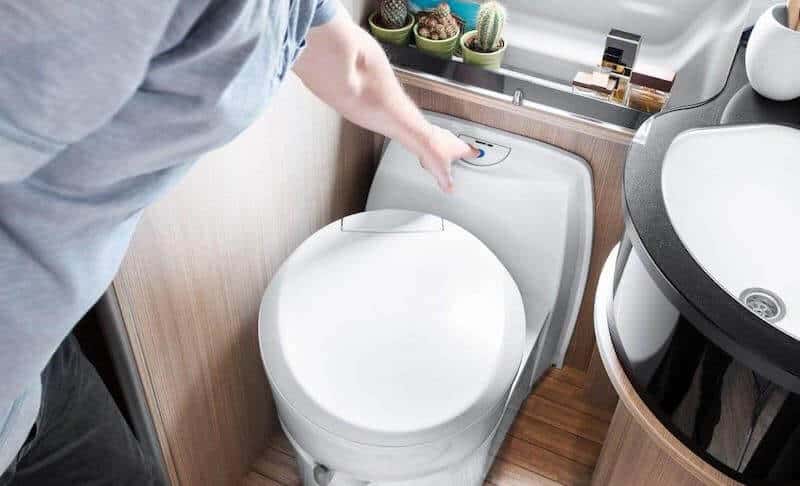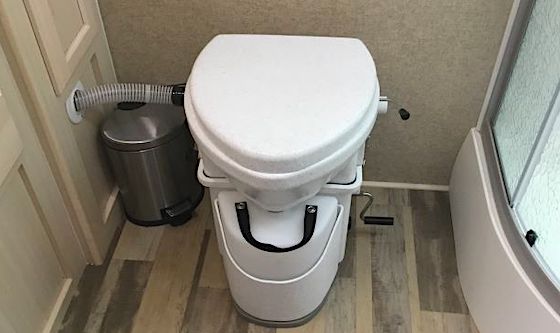Published Date: September 5, 2020
Last Updated on June 22, 2023 by Camper Front
Nothing ruins a great trip faster than a bad bathroom experience. Admittedly, RV toilets are the least talked about aspect of an RV, but if you are planning to go on a long and stress-free trip having the right type of toilet is essential.
You want a toilet that is easy to use, and the waste can be easily disposed of. If your previous RV’s toilet is damaged or you are seeking an upgrade, getting a new RV toilet isn’t difficult.
There are different types of RV toilets, and the one you choose depends on the shape and size of your RV and your own preference.
Hopefully, this article will help you make the right choice of RV toilet.
Table of Contents
Types of RV Toilets
When choosing an RV toilet, there are a couple of factors that come into play, the available space in your RV, the type of maintenance the toilet requires, the cost of installation, and your personal needs.
Suppose the toilet comes with a black tank, you also need to factor in the cost and availability of dumping locations.
Below are the five types of RV toilets available in the market today.
1. Macerator RV toilets
This has more of a fancy design to it than the regular traditional RV toilets; it grinds your waste contents into a slurry that can be stored till you dispose of it.
They are basically motorized grinders that turn your solid waste or anything going into your black holding tank into a slurry that is pumped under pressure longer distances through a much smaller sewer hose or even a garden hose.
The small hose usage enables it to offer a cleaner, less smelly, and simpler dump process. One major feature of a macerator toilet that gives it an edge over other traditional RV toilets is that they can defy gravity.
Most of this type of toilets is electrically or water-powered. Proper care must be taken with these types of RV toilets; a proper backflow assembly must be put in place to prevent the backflow of sewerage into the potable water system of the RV park.
Not only is this unhygienic, but it could cause serious health issues for the users. However, the downside of installing a macerator toilet sometimes outweighs the advantages.
Firstly, the installation process is way more costly than if you were to go for traditional toilets. It uses more water, and they require constant maintenance because while disposing of your waste through a tube might be cleaner, it has to be cleaned regularly to prevent pressure buildup in the tubes, which could cause a huge unpleasant mess.
Read Also: Different Types of RV Window
2. Traditional Gravity Flush RV toilet

The gravity flush toilets are the traditional and most common type of RV toilets; they are just like a household toilet, but with the water holding tank at the back; instead, they are installed above a holding tank, they rely on gravity to flush away your waste content.
They have been in use for quite a long time, so they are well understood in the industry and are very easy to replace or repair. This type of RV toilets is usually connected to an external source of pressurized water, which allows it to function like every regular toilet.
They can be flushed using a foot pump or an electric flush, which empties the contents of the bowl into a sealed-off black tank, which stored the waste until they are disposed of.
You can also purchase chemicals that help to break down solid waste into a smaller consistency that helps to make the dumping process much easier.
The fact that these types of RV toilets resemble the regular home toilet makes going to the toilet more comfortable and makes you feel more at home while on the road.
While installing a gravity flush toilet might be less expensive than other types of RV toilets, they require constant maintenance, and you have to empty the tank periodically, which as to be done at designated sites and can be a smelly and quite messy process.
3. Cassette RV toilets

the cassette toilet looks and works like any other RV toilet; the only difference is that the cassette toilet is fixed permanently atop a bench seat; they cannot be moved or relocated. This toilet has its own fixed four-gallon freshwater holding tank, which is used for flushing.
This tank features a retractable fill spout, which can be accessed outside through a small hatch that allows you to fill it with any kind of flushing water, including regular freshwater, lake water, or even the gray water from your camper.
The removable cassette tank is basically a 5-gallon black water holding tank with wheels. It has a pull handle on one end and two wheels on the other that allow you to drag the cassette behind you like a rolling suitcase.
It also has a convenient pressure release button to help facilitate faster dumping; however, due to the small size of the holding tank, you have to be judicious about how frequent you use the toilet, else you may have to dump every four to five days, lifting the full cassette also pose a problem, the holding tank when full can weigh up to 47 pounds.
Read Also: Different Types of Roof For RVs
4. Portable RV toilet

The portable toilet is similar to a cassette toilet, but it doesn’t require a permanent installment over a tank. Instead, it uses a small, detachable chemical waste tank that sits directly underneath the plastic toilet bowl.
A freshwater holding tank and a hand pump are put in place to enable you to flush out the waste, and whenever the tank is full, you easily empty it into a standard toilet bowl or RV dump station. This is a pretty simple toilet that can be placed anywhere and requires minimal setup.
It is great for those without any bathroom room space in their RV or wouldn’t want to use up valuable storage space for a bathroom; it is also the cheapest toilet option for an RV.
However, when using this toilet, you have to dump out raw sewage directly, no tubes or composting chemicals, everything goes in together and comes out together, which can be pretty gross and smelly.
5. Composting RV toilet

This is the last on this list, and for a good reason, as a camper exploring the highs and lows of nature, you probably try to opt for everything environmentally friendly, trying to reduce your carbon footprint.
This is where this toilet comes in; they are environmentally friendly and make use of no water. With this, toilet liquid and solid wastes are stored separately, and a composting material like coconut coir or sphagnum peat moss is added to breakdown the solids.
With this toilet option, you are free from typical RV toilet troubles like odor, clogs, and regular dumping.
But they require constant emptying and cleaning to avoid getting a smelly mess on your hands, and they are quite expensive to install and operate as you have to continually use the composting materials in order to break down your waste.
This toilet option is mainly suitable for one to two RVers enjoying simplistic camping; it could be a deal-breaker for camping with a lot of guests.
Read Also: How to Prevent RV Pipes From Freezing While Camping
Conclusion
So there you have it, the different types of RV toilets. You have to do proper research and determine your personal preference before heading out on the road with a toilet type, to enable you to get the best out of your trip.

